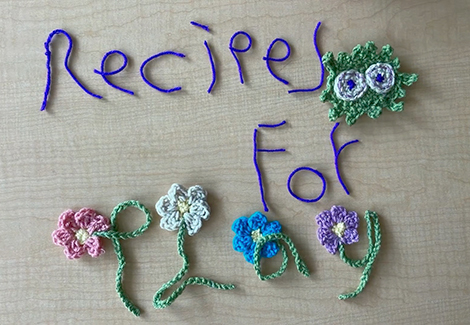Pressing Prairie Flowers
Take some time to smell the flowers, examine them and preserve them as memories of your day for years to come.
What You’ll Need:
- Flowers
- Herb (optional)
- Leaves (optional)
- Large phonebook or dictionary
- More books or heavy objects
Set-Up:
After picking your favorite flowers, leaves or herbs, put them in the refrigerator or freezer to keep them from wilting while you prepare your pressing materials.
What to Do:
- Place the flowers, leaves or herbs on the inside fold of the sheet of newspaper. Make sure there is no overlapping of leaves, petals, or stems and fold the top half of the newspaper sheet down over the flowers.
- Open the dictionary or phone book and place the newspaper in the middle.
- Close the dictionary and place the other books or heavy objects on top. The drying process takes about 3 days. Once the flowers are pressed and dried, you can use them in arrangements, artwork or as gifts.
Ideas for More:
- Paint the flowers with watercolors to restore their natural colors.
- Use the dried flowers to make paper or decorate a journal.
- Make the dried flowers into a picture and frame it.
- Laminate the flowers and make them into bookmarks.
Length of Activity:
Collecting flowers-5 minutes to several years
Pressing flowers-3 days
Resources:
Eaton, Marge, and George Overlie. Flower Pressing. Minneapolis: Lerner Publications, 1973.
Cloud Watching
The walls of the Our Place on the Prairie Gallery have captured South Dakota’s prairie skies, much like Harvey Dunn painted the skies in his work. South Dakota skies are ever changing and cloud watching is a great way to have fun and build your child’s imagination.
What You’ll Need:
- Yourself and your child!
- Blanket
- A sketchpad or paper to draw (optional)
- Pencil or other drawing utensil (optional)
Set-Up:
Find a grassy spot on a sunny day with clouds in the sky. Spread out the blanket on the grassy spot.
What to Do:
- Lay down on the blanket.
- Look up into the sky.
- Point out clouds that look like different objects to you.
- Talk with your child about the different objects and how they change into other objects as the clouds move across the sky.
- Perhaps draw the objects or clouds that you have pointed out as a way to remember them.
Ideas for More:
- Learn about the different types of clouds. There are three levels of clouds: Stratus, Altostratus, and Cirrus. There are many different types of clouds: Stratus, Cumulus, Stratocumulus, Altostratus, Altocumulus, Cirrus, Cirrostratus, Cirrocumulus, and Cumulonimbus. Check out the National Center for Atmospheric Research website for kids listed below.
Moon Journal
The Prairie Play gallery is always changing as the seasons’ change. It also looks different at night. The moon is a fascinating, ever-changing object. Noticing its changes can raise lots of questions about it, the earth, and the environment in which we live.
What You’ll Need:
- Yourself and your child!
- Blanket
- A sketchpad or paper for each to draw and to write
- Pencils, crayons, or other drawing utensils
Set-Up:
Select a place where you can easily view the moon in your front or back yard which is away from yard lights or street lights. While choosing the spot, consider if you will be able to view the moon from that spot during the length of time that you choose to work on your moon journal. You will want a viewing place which you can return to each night for viewing. Then gather the materials that you will need and store them in a convenient spot.
What to Do:
- Choose a length of time that you would like to view the moon. Ideally, in order to capture the full cycle of the moon, 28 days or greater – like 30 days would be a suggested length of time. However, a shorter or longer length of time is fine too.
- Select a time on the first night to go out to view the moon. Choose a time that could be approximately the same time for future nights, so that the location and time of viewing will remain the same over the length of time for viewing the moon.
- While viewing the moon on the first night, each draw a sketch of what it looks like and then spend some time thinking of words to describe it.
- Once finished with the viewing, take some time with your child to add to your drawings in your journals by jotting down your and your child’s thoughts about the experience.
- Finally, choose a way to express your initial thoughts and experience by creating a visual representation of the moon, such as a crayon drawing or a verbal representation, such as a poem about your experience.
Ideas for More:
- After viewing the moon, create a list of curiosity questions for you and your child. Think about and perhaps make a plan to answer a few of the questions at a time.
- Write a poem about your curiosity questions list.
- Create the moon’s shape in 3D using found items around your home.
- Paint how the moon looked and write a poem about it.
- Create a story about the moon, adding in bits of your experience with viewing the moon.
- Write down “a conversation that you might have with the moon” and creatively include the moon’s responses.
- Paint the moon and then use salt dropping to create clouds and stars around it. This is one of the many, many ideas in Moon Journals: Writing, Art, and Inquiry through focused nature study by Joni Chancer & Gina Rester-Zodrow listed below in the Resources section.
- For younger children, read a book about the moon, such as The Best Book of the Moon, by Ian Graham, published by Kingfisher; The Moon Book, by Gail Gibbons; or The Moon, by Michael George.
- For older children who would like to experiment with moon-related ideas, Cosmic Science, by Jim Wiese would be an excellent resource.
Length of Activity:
Initial Viewing: Approximately 5-10 minutes
Initial Reflection Notes: 5 minutes
Culminating Drawing: From 15 minutes to a longer period of time, depending on the drawing or writing activity chosen.
Completing a Full Cycle of the Moon: 28 days
Resources: Chancer, J. & Resler-Zodrow, G. (1997). Moon Journals: Writing, Art, and Inquiry through Focused Nature Study. Portsmouth, NH: Heinemann Publishing.
Zooming In Outside
The prairie seems like a vast open area with little life, yet when one looks more closely, living creatures abound! Zoom in with your child and see what you can find together.
What You’ll Need:
- Your eyes
- String to make a 3-foot loop
- Magnifying glass (optional)
- Binoculars (optional)
Set-Up:
Collect supplies and find an interesting spot in your backyard or local park.
What to Do:
- Take your string and make it into a fun shape like a circle, square or rectangle.
- Observe the different creatures, plants or unique objects are inside the string.
Ideas for More:
- If you have a hula-hoop available you can use it instead of a string.
- Collect interesting leaves or flowers that you see and press them.
- Bring a notepad and paper and draw what you observe.
- Keep some of the insects you found in a jar with holes for further inspection.
- Create a journal of different “Zooming In” experiences.
Length of Activity:
Set Up – 5 to 10 minutes if supplies are readily available
Resource: Ward, Jennifer. I Love Dirt!: 52 Activities to Help You and Your Kids Discover the Wonders of Nature. Boston: Trumpeter, 2008. Print.
Building a Backyard Fort
The Nature Area of the Prairie Play holds opportunities to build forts outside. This idea will extend fort play to a child’s own backyard.
What You’ll Need:
- Three 4’ branches or 1” x 2” boards to use as a frame
- Twine to secure branches or boards together
- Sheet or blanket to cover frame
Set-Up:
Collect supplies and select a spot in the back yard to build the fort.
What to Do:
- Use the twine to secure the three boards or branches together at one end – about 6” in from the ends.
- Stand the boards or branches on end and spread out so that the boards/branches balance against each other.
- Spread the sheet or blanket across the boards or branches.
- Select a doorway area for the fort.
- Enjoy!
Ideas for More:
- It’s possible to make it considerably rainproof by using a tarp or plastic sheet instead.
- Furnish your fort. This can be anything from pictures to pillows or cushions.
- Create a welcome mat for your outdoor fort.
- Create a fort in a tree – this is more of an extensive outdoor project.
Length of Activity:
Set Up – 5 minutes if supplies are readily available
Building the Fort – 10 minutes to several hours
Resource: http://www.wikihow.com/Build-an-Outdoor-Fort



